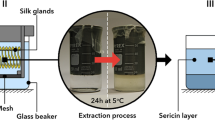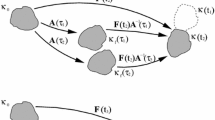Abstract
Natural fibers are particularly interesting from a materials point of view since their morphology has been tailored to enable a wide range of macroscopic level functions and mechanical properties. In this paper, we focus on mussel byssal threads which possess a morphology specifically designed to provide a hysteretic yet resilient large strain deformation behavior. X-ray diffraction studies have shown that numerous natural fibers have a multi-domain architecture composed of folded modules which are linked together in series along a macromolecular chain. This microstructure leads to a strong rate and temperature dependent mechanical behavior and one which exhibits a stretch-induced softening of the mechanical response as a result of the underlying morphology evolving with imposed stretched. This paper addresses the development of a constitutive model for the stress–strain behavior of the distal portion of mussel byssal threads based on the underlying protein network structure and its morphology evolving with imposed stretched. The model will be shown to capture the major features of the stress–strain behavior, including the highly nonlinear stress–strain behavior, and its dependence on strain rate and stretch-induced softening.



















Similar content being viewed by others
References
Bairati A, Vitellaro-Zuccarello L (1976) Cell Tiss Res 166:219
Benedict CV, Waite JH (1986) J Morphol 189:261
Bairati A (1991) In: Lanzavecchia G, Valvassori R (eds) Form and function in zoology. Mucchi, Modena, pp 163–177
Bell E, Gosline JM (1996) J Exp Biol 199:1005
Carrington E, Gosline JM (2004) Am Malacol Bull 18:135
Coyne KJ, Qin XX, Waite JH (1997) Science 277:1830
Waite JH, Qin XX, Coyne KJ (1998) Matrix Biol 17:93
Hassenkam T, Gutsmann T, Hansma P, Sagert J, Waite JH (2004) Biomacromolecules 5:1351
Yi J, Boyce MC, Lee GF, Balizer E (2006) Polymer 47:319
Deschanel S, Boyce MC, Cohen RE (2007) Rate dependent mechanical performance of Ethylene Methacrylic Acid (EMAA) copolymers and POSS-enhanced EMAA nanocomposites. Proceedings of ACS Spring Meeting—Symposyum on segmental block copolymers, Chicago
Qi HJ, Boyce MC (2005) Mech Mater 37:817
Socrate S, Boyce MC (2000) J Mech Phys Solids 48:233
Gurtin ME (1972) In: Flugge S (ed) Handbuch der Physik, vol 6a(2). Springer, Berlin
Spencer AJM (ed) (1984) In: Continuum theory of the mechanics of fibre-reinforced composites. Springer-Verlag, New-York, pp 1–32
Bischoff JE, Arruda EM, Grosh K (2002) J Appl Mech 69:570
Bischoff JE, Arruda EM, Grosh K (2002) J Appl Mech 69:198
Holzapfel GA (2000) Nonlinear solid mechanics, a continuum approach for engineering. John Wiley and Sons, Chichester
Holzapfel GA (2003) In: Holzapfel GA, Ogden RW (eds) Biomechanics of soft tissue in cardiovascular systems CISM lectures, vol 441. Springer, Wien, pp 109–184
Horgan CO, Saccomandi G (2005) J Mech Phys Solids 53:1985
Cantournet S, Boyce MC, Tsou AH (2007) J Mech Phys Solids 55:1321
Sun C, Vaccaro E, Waite JH (2001) Biophys J 81:3590
Ogden RW (1984) Non-linear elastic deformations. Ellis Horwood, Chichester
Boyce MC, Arruda EM (2000) Rubber Chem Technol 73:504
Rief M, Gautel M, Oesterhelt F, Fernandez JM, Gaub HE (1997) Science 276:1109
Oberhauser AF, Marszalek PE, Erickson HP, Fernandez JM (1998) Nature 393:181
Fisher TE, Oberhauser AF, Carrion-Vazquez M, Marszalek PE, Fernandez JM (1999) TIBS 24:379
Smith BL, Schäffer TE, Viani M, Thompson JB, Frederick NA, Kindt J, Belcher A, Stucky GD, Morse DE, Hansma PK (1999) Nature 399:761
Kroner E (1960) Arch Ration Mech Anal 4:273
Lee EH (1969) ASME J Appl Mech 36:1
Odijk T (1995) Macromolecules 28:7016
Wang MD, Yin H, Landick R, Gelles J, Block SM (1997) Biophys J 72:1335
Qi HJ, Ortiz C, Boyce MC (2006) J Eng Mater Technol 128:509
Eyring H (1936) J Chem Phys 4:283
Bell GI (1978) Science 200:18
Minajeva A, Kulke M, Fernandez JM, Linke WA (2001) Biophys J 80:1442
Dorfmann A, Trimmer BA, Woods WA Jr (2006) J R Soc Interface (on line)
Mohandas N, Evans E (1994) Annu Rev Biophys Biomol Struct 23:787
Arslan M, Boyce MC (2006) J Appl Mech 73:536
Gosline JM, Guerette PA, Ortlepp CS, Savage KN (1999) J Exp Biol 202:3295
Qi HJ, Bruet BJF, Palmer JS, Ortiz C, Boyce MC (2005) In: Holzapfel GA, Ogden RW (eds) Mechanics of biological tissues. Proceedings IUTAM. Springer-Verlag, Graz, Austria, pp 180–205
Carrington E (2002) Limnol Oceanogr 47:1723
Moeser GM, Carrington E (2006) J Exp Biol 209:1996
Acknowledgments
This research was supported by the Dupont—MIT Alliance.
Author information
Authors and Affiliations
Corresponding author
Appendices
Appendix A: Derivation of the strain energy contribution due to unbending
Approximating the bent fiber to consist of two straight segments of length L 1 and L 2 connected by a circular bend of length ρ α (with α = α1 + α2), as shown in Fig. 12, a form for the force-stretch behavior of the unbending of a single fiber is derived. Both segments are assumed to be rigid, so that all the deformation is accommodated by unbending of the kinked region. In addition, the contour length of the kink is assumed to be fixed (i.e. stretching of the kink region is neglected), so that
Figure 12 clearly shows that the angles α1 and α2 satisfy the condition
and, taking L > > ρ α, the fiber stretching λ = r/r 0 may be approximated as
so that from Eqs. A.2 and A.3 α1 and α2 may be expressed as a function of λ as
The strain energy of the fiber due to the unbending of the bend is given by
where EI is the bending stiffness and Δκ denotes the change in curvature of the bend
Substitution of Eq. A.6 into Eq. A.5 yields
so that the fiber force-stretch behavior is given by
Note that in case of a symmetrically bent fiber (i.e. L 1 = L 2), Eq. A.8 reduces to
Appendix B: Parameter identification for the constitutive model
The mussel byssus is a biological material and thus its mechanical properties are observed to vary, mostly influenced by the season, the temperature, the water salinity [41, 42]. Thus the identification of material parameters entering in the constitutive model is aleatoric and related to all these effects. However, Figs. 1 and 4 clearly show that the stress–strain behavior of the distal segment consists of three different regions (Fig. 20):
-
an initial linear response: it is used to identify the value of the fiber Young’s modulus E;
-
‘yielding’ followed by stretch-induced softening: the ‘yielding’ points at different strain rates are used to identify the unfolding parameters x u and α u ;
-
strain hardening: it permits us to identity the length of the fully unfolded fiber L max.
The geometrical parameters θ0, L 10, L 20, H 0 and d have all been be measured with transmission electron microscopy and the values reported in Hassenkam et al. [8] are used.
To better facilitate the identification of the material parameters entering in the constitutive model additional tests are needed:
-
additional tensile tests at multiple strain rates to better understand the rate-dependence of ‘yield’;
-
Relaxation tests to better understand the sources of the rate-dependence;
-
Unloading–reloading tests at higher strain rates to better understand the unloading/reloading process;
-
Force test of a single macromolecule to validate the choice of material parameters.
Rights and permissions
About this article
Cite this article
Bertoldi, K., Boyce, M.C. Mechanics of the hysteretic large strain behavior of mussel byssus threads. J Mater Sci 42, 8943–8956 (2007). https://doi.org/10.1007/s10853-007-1649-z
Received:
Accepted:
Published:
Issue Date:
DOI: https://doi.org/10.1007/s10853-007-1649-z





